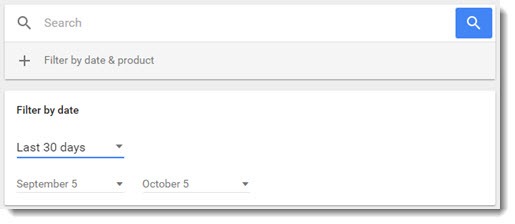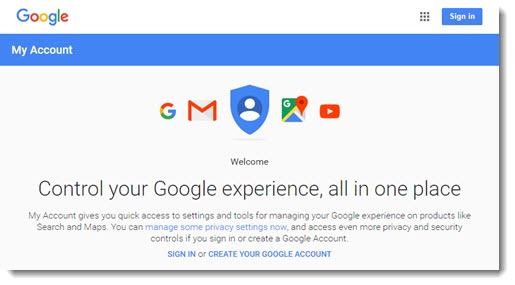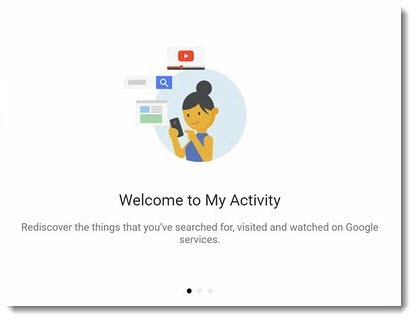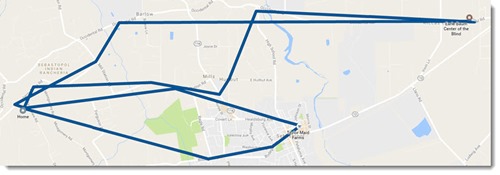You have a vague idea that Google knows a lot about you.
You’re right.
Google has nothing to hide. It’s prepared to show you everything it has collected about you.
Are you sure you want to know? It’s a bit . . . creepy.
A few months ago Google created a tool named “My Activity” that gathers all its personal information about you into one place. You can review it easily. You can delete things that you would prefer not to have in Google’s records – even delete all of it. Mostly, you can be amazed that it exists.
First, some background about what you’re going to see; then I’ll describe some of the highlights in the My Activity center, and give you a closing thought about why this might actually be okay.
Your Google Account
Almost everyone has a Google account. It’s an email address and a password that connects you to Google services.
• A Gmail address is also a Google account.
• If you have an Android phone, it is connected to a Google account.
• If you see your name at the upper right corner of Google websites when you’re using Chrome, you’re logged into your Google account.
• If you use Google Maps on your iPhone, it’s probably connected to your Google account.
• If you upload photos to Google Photos, they’re connected to your Google account.
Google may still have data about you if you don’t use Chrome and don’t have a Google account, but My Activity is for people with Google Accounts. The more Google services you use, the more information will be stored there.
With that in mind, let’s visit My Activity. Log in with your Google account.
Google My Activity
The list in the middle shows all the websites you visited today. It might be just the history from the device you’re using at that moment, or it might be from all devices – computer, phone, tablet. (There’s a setting under “Activity controls” that toggles that on and off.)
Scroll down. You’ll notice it keeps going. Yup, you’re getting it. That’s your web browsing history since the beginning of time. Every page you’ve visited using Chrome signed into your Google account. For many of you, that means many years of web browsing history that you thought was long forgotten. Google doesn’t forget.
Okay, you’re freaking out. I understand.
First, this information is private. It is only available to you. No one else can see it. Google takes your privacy seriously. We’re all afraid that the NSA is rummaging through everything freely but most of you aren’t very interesting from their perspective. But your spouse or your boss or your mom can’t see this web history. (Changed your Google Account password lately?)
Second, if you’re deeply concerned about something, you can find it and delete it. Don’t go nuts and spend hours trying to cleanse these records. Life is too short. But if you must, search for whatever Must Not Be Found and delete it. (Click on the three dots on the right.)

With that in mind, notice a couple of things. At the top you can click on “Filter by date & product” and find a particular date.
Also at the top you can click on YouTube and get a list of every YouTube video you’ve watched, listed chronologically and searchable.
Oh, there’s more. You can export an archive of every Google search you’ve ever done. If you have an Android phone or tablet, there’s information about things that have happened on those devices.
There’s one more thing that strays deeply into spooky territory.

You probably use Google Maps on your phone. And if you’re like most people, it asked for permission for some stuff the first time you used it and you said okay.
On the My Activity page, click on Other Google activity. Under “Location History,” click on Visit Timeline.
Gulp. Those red dots on the world map look like places you’ve visited.
Click on Today or choose a date from the date picker in the upper left.
I use Google Maps and the Google app on my iPhone. I said OK to some stuff when they were first installed.
The picture above is a map of where I drove yesterday. The day before that the map also showed where I walked, because the phone was in my pocket during my walk.
I didn’t look those places up yesterday. The phone is always keeping track of where I am and sending that information to Google. Always.
On that first Timeline screen (you can get back there by clicking on Timeline in the upper left), try the squares at the bottom. You can see a list of the places you visit most frequently. You can see maps of significant trips that Google has constructed automatically.
When this was first introduced last year Google’s product manager said: “”Have you ever wanted a way to easily remember all the places you’ve been — whether it’s a museum you visited during your last vacation or that fun bar you stumbled upon a few months ago? Well, starting today, Google Maps can help. We’re gradually rolling out Your Timeline, a useful way to remember and view the places you’ve been on a given day, month or year. Your Timeline allows you to visualize your real-world routines, easily see the trips you’ve taken and get a glimpse of the places where you spend your time. And if you use Google Photos, we’ll show the photos you took when viewing a specific day, to help resurface your memories.”
Maybe you don’t use Google Maps or didn’t agree to some of the things that make this possible. But if you’re like me and you’re seeing this collection of data for the first time, you’re probably having a whoa moment.
Getting over the creepy feeling

All of the data in My Activity is in your control. There are instructions on this Help page about how to turn various types of data collection on and off and how to delete past activity. Don’t be too quick to do that.
I’m starting to believe that Google will be as important to our lives in the next ten years as Microsoft was during the years when it singlehandedly defined our relationship to technology.
The more data you give to Google, the more it will give back to you.
Artificial intelligence is this week’s buzzword in the tech world. Google presented a variety of new products on Tuesday – new phones, new routers to create a mesh network (like the ones I wrote about recently), and a home device that answers voice commands like Amazon Echo.
The hardware is interesting but Google’s ambition is actually focused on Google Assistant – the highly personalized way that Google will be getting smarter and smarter about everything that you do, helping you do things more easily and predicting your needs. The Verge reported this from the Tuesday event:
“Using artificial intelligence and its new digital assistant, said Google CEO Sundar Pichai, Google’s computing power will be available in every facet of users’ lives. It’ll be seamless and pervasive. “Our goal,” he said, “is to build a personal Google for each and every user.” Not a single Google that we all can use, but an individualized Google for everyone.
“For the concept to actually work in the way the company promises, Google needs two things: better artificial intelligence, and more information about your life than you ever knew existed.”
We already use Google services for more than you would have predicted a few years ago. It gets us where we’re going, its search results are increasingly personal, and it handles mail, calendar, and documents for many people. Now we are beginning to see the fruits of the project to use deeper analysis of that data to help us. It’s the boarding pass that’s waiting for us on the phone because Google spotted the flight on our calendar or in a confirming email. It’s the reminder on our phone to leave early for an appointment because of a traffic delay. It’s the email with theater tickets brought to the front on the night of the show. It’s the ability to say, “OK, Google, what’s my bike lock combination?” because you asked Google to keep track of it a few weeks ago. It’s devices that can pass information and commands among themselves because Google is working on all of them. When I save a bookmark on Chrome on my laptop, I know it will be available on my phone or my office computer. I don’t think about it, I don’t plan it, it’s just there when I need it.
And mostly it’s the things that we can’t think of yet because they haven’t been invented or the rough edges are still being worked out. A lot of it will be conversational, talking to our phone or to the Google Home device and getting smarter answers every day. Google Assistant today is similar to Siri and Cortana – all of them are early, primitive sketches that work erratically. But the big tech companies have been engaged in their arms race behind the scenes for years to improve them and that technology is about to get better very fast.
Google stands to take a commanding lead because it has the best data and the most data. The more data Google has, the more it will do for you.
I surrendered any illusion of privacy when I uploaded our family albums to Google Photos. The rewards have been huge – being able to find pictures by searching any way I want because Google has indexed everything about them. Let Google collect its data! You can’t escape the world we live in, and there will be rewards if you choose to take advantage of them.




